I am working on a very low level part of the application in which performance is critical.
While investigating the generated assembly, I noticed the following instruction:
lea eax,[edx*8+8]
I am used to seeing additions when using memory references (e.g. [edx+4]), but this is the first time I see a multiplication.
- Does this mean that the x86 processor can perform simple multiplications in the lea instruction?
- Does this multiplication have an impact on the number of cycles needed to execute the instruction?
- Is the multiplication limited to powers of 2 (I would assume this is the case)?
Thanks in advance.
